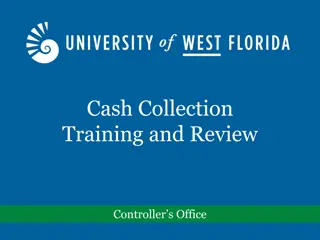Importance of Cash Flow Analysis in Financial Management
Cash flow analysis is a crucial financial tool for effective cash management, aiding in evaluating financial policies and positions. It helps in planning, coordinating financial operations, assessing cash needs, and meeting obligations. However, it has limitations as it does not substitute the income statement and may not reflect the true liquid position of a business. Contrasting fund flow statement with cash flow statement, the former focuses on working capital changes, while the latter emphasizes cash and cash equivalents adjustments. Cash flow analysis is beneficial for short-range financial planning, while fund flow statement is ideal for long-range financial planning due to its emphasis on working capital. Preparation of cash flow statement includes classifying cash flows into operating, investing, and financing activities.
Download Presentation

Please find below an Image/Link to download the presentation.
The content on the website is provided AS IS for your information and personal use only. It may not be sold, licensed, or shared on other websites without obtaining consent from the author.If you encounter any issues during the download, it is possible that the publisher has removed the file from their server.
You are allowed to download the files provided on this website for personal or commercial use, subject to the condition that they are used lawfully. All files are the property of their respective owners.
The content on the website is provided AS IS for your information and personal use only. It may not be sold, licensed, or shared on other websites without obtaining consent from the author.
E N D
Presentation Transcript
USES OF CASH FLOW STATEMENT: Cash flow analysis is an important financial tool for the management. its chief advantages are as follows: Helps in efficient Cash Management. It helps in evaluating financial policies and cash position. Cash is the basis for all operations and hence a projected cash flow statement will enable the management to plan and coordinate the financial operations properly. The management can know how much cash is needed from which source it will be derived, how much can be generated internally and how much can be obtained from outside. With the help of cash flow statement management can evaluate its ability to meet its obligations such as payment of loan, payment to creditors, payment of interest, dividend and taxes. It throws light on the factors responsible for inadequate cash balance despite of an increase in profits or vice versa. A projected cash flow statement can be prepared in order to know the future cash position of a concern so as to enable a firm to plan and coordinate its financial operations properly. It discloses the success or failure of cash planning. The extent of success of cash planning can be known by comparing the projected cash flow statement with the actual cash flow statement and necessary remedial measures can be taken.
LIMITATIONS A cash flow statement is not a substitute for the income statement. An income statement takes into account both cash as well as non-cash items. Hence net cash flow does not necessarily mean net income of the business. The cash balance as disclosed by the cash flow statement may not represent the real liquid position of the business. Since it can be easily influenced by postponing purchases and other payments. Cash flow statement ignores non-cash charges. Non-cash charges will have to be taken in to account for judging the profitability of an enterprise. FUND FLOW STATEMENT V/S CASH FLOW STATEMENT: The funds flow statement is based on wider concept of working capital. Cash flow statement is based on the narrow concept of fund i.e. cash only. Fund flow statement discloses the magnitude direction and the causes of changes in working capital. Cash flow statement discloses the magnitude direction and causes changes in cash and cash equivalents. Funds flow analysis is based on the accrual basis of accounting. Cash flow analysis is based on the cash basis of accounting.
Fund flow statement is useful for the long-range financial planning since in the long run the firm is interested in working capital because all the items of working will ultimately change into cash. Cash flow analysis is useful for short-range financial planning. Funds flow statement tallies the funds generated from various sources with various uses to which they are put. Cash flow statements start with the opening balance of cash and reaches to the closing balance of cash by proceeding through sources and uses. In a fund flow analysis, classification of assets and liabilities items into current category items and non-current category items is necessary. But no such classification is necessary in a cash flow analysis. PREPARATION OF CASH FLOW STATEMENT The cash flow statement should report cash flows during the period classified by Operating, Investing and Financing activities:
Cash flows from operating activities: Cash flows from operating activities are primarily derived from the principal revenue producing activities of the enterprise. Generally, this results from the transactions and other events that enter into the determination of net profit/loss. Examples of cash flow from operating activities: Cash receipts from sale of goods. Cash receipts from royalties, fees, commission. Cash payments to supplies of goods. Cash payments to and on behalf of employees. Cash payments or refunds of income taxes.
Cash flows from Investing Activities: Investing activities are the acquisition and disposal of long-term assets and other investments not included in cash equivalents. Cash flow from investing activities is ascertained by analysing the changes in Fixed Assets and long-term investments in the beginning and at the end of the year. Examples: Cash payments to acquire fixed assets. Cash receipts from disposal of fixed assets. Cash payments to acquire shares, warrants. Cash receipts from disposal of Shares, Warrants. Cash advances and loans made to third parties. Cash receipts from the repayment of advances and loans made to third parties.
Cash flows from financing Activities: Financing activities are activities that result in changes in the size and composition of the owner s capital and borrowing of the enterprise. Cash flow financing activities is ascertained by analysing the changes in Equity Share, Preference Share Capital, Debentures and other long-term borrowings. Examples: Cash proceeds from issuing shares. Cash proceeds from Debentures. Cash proceeds from short and long-term borrowings. Cash payment for buy-back of equity shares. Cash payments for redemption of preference shares. Cash payment of amount borrowed. Cash payment for equity and preference dividend. Cash payments for Interest on Debentures and loans.





















